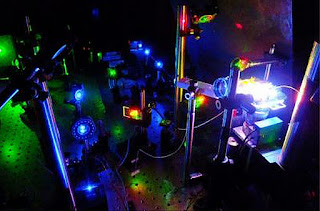A special group of proteins, the so-called chaperons, helps other proteins to obtain their correct conformation. Until now scientists supposed that hydrolyzing ATP provides the energy for the large conformational changes of chaperon Hsp90. Now a research team from the Nanosystems Initiative Munich could prove that Hsp90 utilizes thermal fluctuations as the driving force for its conformational changes. The renowned journal PNAS reports on their findings.
ATP is the major energy source for most organisms and ATPases are the machines, which utilize this fuel, for example to move muscles or cargo in our body. The very abundant chaperone protein Hsp90 has such an ATPase in each of its two monomers. During the last years experiments had suggested that the movement and conformational changes of ATPase proteins are in general strictly linked to ATP binding and hydrolysis (i.e. fuel consumption).
To probe this theory Thorsten Hugel, Professor at the Technische Universitaet Muenchen (TUM) and member of the Nanosystems Initiative Munich (NIM), and his team designed a special three color single-molecule FRET (Förster resonance energy transfer) assay with alternating laser excitation (ALEX) for simultaneous observation of ATP binding and conformational changes. Unexpectedly the experiments revealed that binding and hydrolysis of ATP is not correlated with the large conformational changes of Hsp90. Hsp90 is instead a highly flexible machinery driven by thermal fluctuations.

Caption: With their specially designed three-color single-molecule FRET (Foerster resonance energy transfer) assay with alternating laser excitation (ALEX) for simultaneous observation of ATP binding and conformational changes professor Hugel and his team could prov, that Hsp90 utilizes thermal fluctuations for its large conformational changes. Credit: Christoph Ratzke. Usage Restrictions: None."Thermal fluctuations are random changes in the structure of the protein â€" they can be thought of as collisions with water molecules in the environment, which move rather violently at the temperatures in a living organism," says Thorsten Hugel. "Using these clashes to switch back and forth between different conformations, saves Hsp90 valuable ATP." But then what is the task of ATPase in the Hsp90 chaperone? The scientists suspect that co-chaperones and substrate proteins alter the system so that ATP binding or hydrolysis can take a crucial task.
With the newly developed experimental setup, it is now possible to investigate the very complex system in greater detail to resolve this important question. The Munich biophysicists therewith offer a new perspective on the energy conversion in molecular machines.
###
The work was supported by grants from the DFG (Hu997/9-1, SFB 863) and the Cluster of Excellence Nanosystems Initiative Munich (NIM) and the NanoBio-Technology program of the Elite Network of Bavaria.
Original publication:
Heat shock protein 90's mechano-chemical cycle is dominated by thermal fluctuations Christoph Ratzke, Felix Berkemeier, and Thorsten Hugel, PNAS, January 3, 2012 vol. 109, no. 1, 161-166 â€" Doi: 10.1073/pnas.1107930108
Contact: Dr. Andreas Battenberg battenberg@zv.tum.de 49-892-891-0510 Technische Universitaet Muenchen
